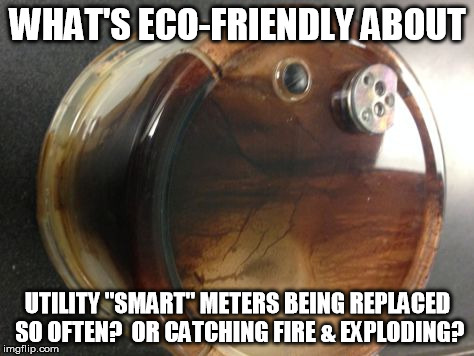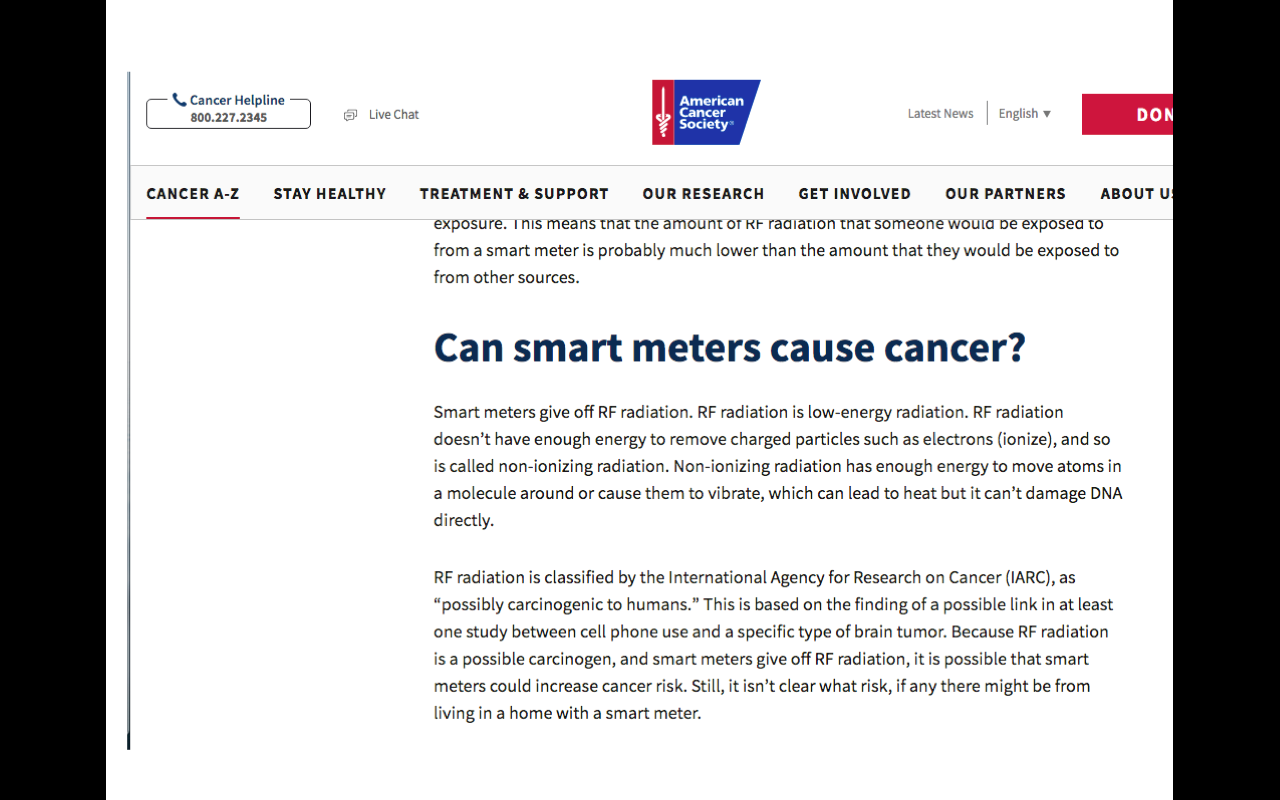 By B.N. Frank
By B.N. Frank
American opposition to expensive, hazardous, and privacy invasive utility “Smart” Meters (electric, gas, and water) has been ongoing since companies first started deploying them. These devices are so awful that a free online documentary was produced about them in 2013 and then updated in 2017. Adding insult to injury, the high costs associated with purchasing, installing, and replacing them are usually passed on to customers (see 1, 2, 3).
Despite all the problems associated with these meters – including fires and explosions (see 1, 2, 3) and health risks – proponents are celebrating a deployment milestone in the U.S.
From Utility Dive:
US smart meter penetration hits 65%, expanding utility demand response resources: analysts
Dive Brief:
- As of 2020, about 65% of electricity meters across the United States had “smart” capabilities including integrated data processing and two-way communications, according to Guidehouse Senior Research Analyst Michael Kelly. The penetration of advanced metering infrastructure (AMI) has been steadily growing by about 4-5% annually since 2016, he said.
- Utilities are headed towards about 90% AMI uptake by the end of the decade, though penetration varies by type, according to Guidehouse data. Cooperative utilities have about 78% smart meters on their systems, while investor-owned utilities sit around 65% and public power companies at 55%.
- The growth in smart meters is helping utilities expand their load management programs. The smart meter installed base grew by 9.3% between 2017 and 2020, while the demand response customer base grew by 7.3% over the same period, said Kelly.
Dive Insight:
Smart meters are a foundational part of the energy transition and can help transform electric vehicle (EV) and building electrification efforts into flexible grid resources. Tens of millions of older meters remain on the grid, and the full transition will take more than a decade, but Kelly said progress on replacing them has been steady for years.
“The only kind of barrier would be on the regulatory side,” said Kelly. And increasingly, regulators are seeing the value of AMI, he added.
Kentucky regulators in 2018 rejected proposals by Kentucky Utilities and Louisville Gas & Electric to install AMI across their territories, but reversed course and approved plans in June for more than 900,000 smart electric meters. In New Jersey, Public Service Electric & Gas got approval in January to install 2.3 million smart meters. New Mexico is now considering grid modernization applications at the direction of lawmakers.
Getting regulators on board requires educating them on the range of benefits that smart meters can provide, Kelly said. But for utilities, accessing the benefits will require more than deployment, he added.
Kelly co-authored a white paper commissioned by software company Grid4C that concluded “the full value proposition behind smart meter deployments has yet to be fully realized. Immediate benefits around workforce optimization, billing accuracy, and outage detection represent the tip of the iceberg in potential value creation.”
“The disconnect stems from an underutilization of smart meter data and an underinvestment in smart meter analytics,” Kelly wrote.
Rather than collecting meter readings every five or 15 minutes, new meters can record usage data at sub-second intervals, Kelly said. That opens up a lot of potential — while also introducing complexity for utilities.
“Do you have the communications bandwidth to send hundreds of thousands of data points? Probably not,” Kelly said. A new wave of AMI solves that problem by moving the analytics and storage onto the meter itself, he said.
“More granular collection intervals … opens up a whole new set of applications around the power quality, which smart meters have never been able to do before,” he said.
Utilities are taking advantage of the growing number of smart meters on their systems, according to data from the Federal Energy Regulatory Commission. The agency’s 2021 Assessment of Demand Response and Advanced Metering shows that from 2018 to 2019 enrollment in retail incentive-based demand response programs increased by 1.1 million customers, and enrollment in retail dynamic pricing programs increased by 1.7 million customers. The enrollments represent annual percentage increases of 12% and 19%, respectively, according to the report published this month.
“That’s a good sign that more utilities are starting and/or growing DR programs,” Guidehouse Research Director Brett Feldman said in an email.
Part of the increase in retail dynamic pricing programs coincides with the California Public Utilities Commission’s 2015 decision “requiring utilities to transition customers to default time-of-use rates beginning in 2018 and 2019,” FERC noted in the report.
There is not a lot of dynamic pricing uptake outside of California, said Feldman, “but some utilities are still trying pilots to find models that work for customers, especially as solar, storage, and EVs grow.”
The report found from 2019 to 2020 demand resource totals in wholesale markets decreased by approximately 4% to a total of 30,787 MW. But despite the nationwide decrease in demand resources, FERC also concluded “wholesale demand resource potential to meet peak loads increased” across the same period due to lower peak demand in 2020.
“The decreased load is due to a combination of Covid and a general trend of flattening and decreasing loads due to greater energy efficiency,” Feldman said. “However, that trend is reversing with more electric vehicles and electrification of heating in buildings.”
Activist Post reports regularly about utility “Smart” Meters and other unsafe technology. For more information, visit our archives and the following websites:
- Coalition to Stop Smart Meters
- EMF Safety Network
- StopSmartMeters
- Smart Meter Harm
- Smart Grid Awareness
- Smart Meter News
- Smart Meter Education Network
- Take Back Your Power
- The People’s Initiative
- Wireless Information Network
- Electromagnetic Radiation Safety
- Environmental Health Trust
- Physicians for Safe Technology
- Wireless Information Network
Become a Patron!
Or support us at SubscribeStar
Donate cryptocurrency HERE
Subscribe to Activist Post for truth, peace, and freedom news. Follow us on Telegram, HIVE, Flote, Minds, MeWe, Twitter, Gab and What Really Happened.
Provide, Protect and Profit from what’s coming! Get a free issue of Counter Markets today.


Be the first to comment on "U.S. Smart Meter Deployment Now at 65% Despite High Costs, Various Hazards, and Increasing Opposition"